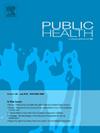酒精饮料类型与全因死亡率之间的关系一项基于人群的前瞻性研究
IF 3.9
3区 医学
Q1 PUBLIC, ENVIRONMENTAL & OCCUPATIONAL HEALTH
引用次数: 0
摘要
目的酒精饮料种类与死亡率之间的差异关系尚无定论。本研究旨在评估西班牙成年人群中各种酒精饮料消费与全因死亡率之间的关系。研究设计基于人群的队列研究。方法本研究纳入参加2011年西班牙健康调查或2014年西班牙欧洲健康调查的16130名年龄≥15岁的每周饮酒者。参与者的数据与截至2022年12月的死亡率数据相关,中位随访时间为8.4年。当超过50%的酒精摄入量来自葡萄酒、啤酒或烈酒时,就可以定义为对葡萄酒、啤酒或烈酒的偏好。此外,每种饮料的总酒精摄入量被分为四组:0克/天、0 - 10克、10-20克、20克/天。使用Cox回归对社会人口因素、生活方式、健康状况、酒精摄入量和重度间歇性饮酒进行校正,估计风险比(HR)。结果与没有饮料偏好的个体相比,偏好葡萄酒、啤酒或烈酒的死亡率的HR (95% CI)分别为1.09(0.88-1.35)、1.22(0.96-1.54)和1.16(0.82-1.65)。在低风险饮酒者(0 - 20克/天)中,偏爱啤酒的人死亡率更高(风险比:1.35(1.01-1.81))。与没有摄入葡萄酒、啤酒或烈酒的参与者相比,最高消费类别(每天20克)的参与者在饮料偏好方面的死亡率没有显着差异。结论:对葡萄酒、啤酒或烈性酒的参考并没有显示出酒精消费与全因死亡率之间存在一致的差异影响。本文章由计算机程序翻译,如有差异,请以英文原文为准。
Association between type of alcoholic beverage and all-cause mortality. A population-based prospective study
Objectives
Evidence on the differential relationship between type of alcoholic beverage consumed and mortality remains inconclusive. This study aims to evaluate the association between consumption of various alcoholic beverages and all-cause mortality in the Spanish adult population.
Study design
Population-based cohort study.
Methods
This study included 16,130 weekly alcohol drinkers aged ≥15 years who participated in the 2011 Spanish Health Survey or the 2014 European Health Survey in Spain. Data of the participants was linked to mortality data up to December 2022, with a median follow-up time of 8.4 years. A preference for wine, beer, or spirits was defined when more than 50 % of alcohol intake was obtained from such beverage. Additionally, total alcohol intake for each beverage type was categorized into four groups: 0 g/day, >0–10, >10–20, >20g/day. Hazard Ratios (HR) were estimated using Cox regression adjusted for sociodemographic factors, lifestyle, health status, alcohol volume intake, and heavy episodic drinking.
Results
Compared to individuals without a beverage preference, the HR (95 % CI) for mortality among those with preference for wine, beer or spirits was 1.09 (0.88–1.35), 1.22 (0.96–1.54), and 1.16 (0.82–1.65), respectively. Among low-risk drinkers (>0–20g/day), those with a preference for beer showed a higher mortality (HR: 1.35 (1.01–1.81)). Compared to participants with zero intake of wine, beer or spirits, those in the highest consumption category (>20g/day) showed no significant differences in mortality by beverage preference.
Conclusions
Preference for wine, beer, or spirits did not show a consistently differential impact on the association between alcohol consumption and all-cause mortality.
求助全文
通过发布文献求助,成功后即可免费获取论文全文。
去求助
来源期刊

Public Health
医学-公共卫生、环境卫生与职业卫生
CiteScore
7.60
自引率
0.00%
发文量
280
审稿时长
37 days
期刊介绍:
Public Health is an international, multidisciplinary peer-reviewed journal. It publishes original papers, reviews and short reports on all aspects of the science, philosophy, and practice of public health.
 求助内容:
求助内容: 应助结果提醒方式:
应助结果提醒方式:


